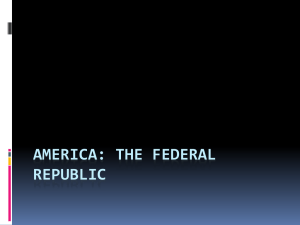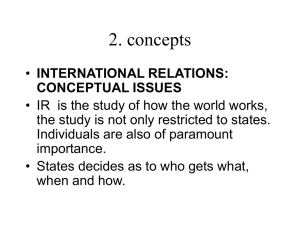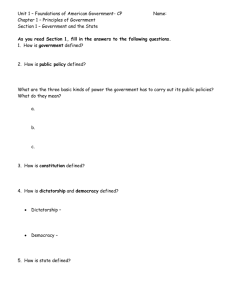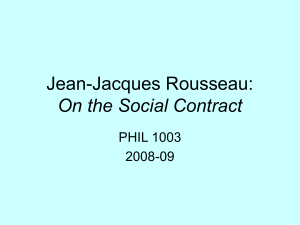Remarks made before the United Nations General Assembly
advertisement
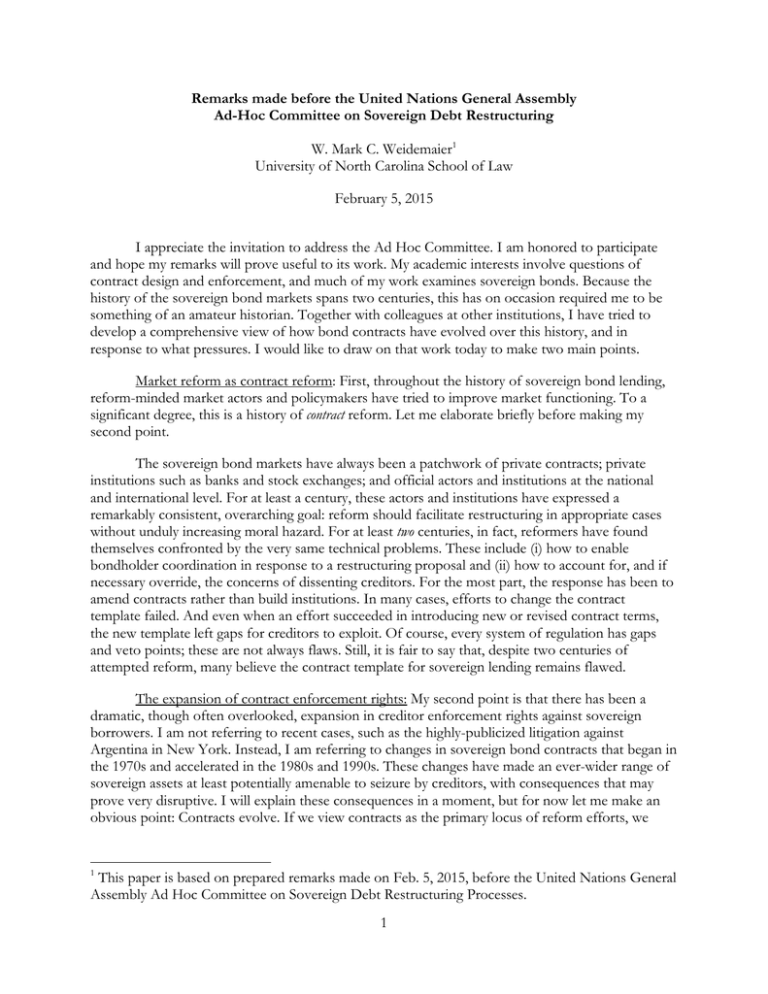
Remarks made before the United Nations General Assembly Ad-Hoc Committee on Sovereign Debt Restructuring W. Mark C. Weidemaier1 University of North Carolina School of Law February 5, 2015 I appreciate the invitation to address the Ad Hoc Committee. I am honored to participate and hope my remarks will prove useful to its work. My academic interests involve questions of contract design and enforcement, and much of my work examines sovereign bonds. Because the history of the sovereign bond markets spans two centuries, this has on occasion required me to be something of an amateur historian. Together with colleagues at other institutions, I have tried to develop a comprehensive view of how bond contracts have evolved over this history, and in response to what pressures. I would like to draw on that work today to make two main points. Market reform as contract reform: First, throughout the history of sovereign bond lending, reform-minded market actors and policymakers have tried to improve market functioning. To a significant degree, this is a history of contract reform. Let me elaborate briefly before making my second point. The sovereign bond markets have always been a patchwork of private contracts; private institutions such as banks and stock exchanges; and official actors and institutions at the national and international level. For at least a century, these actors and institutions have expressed a remarkably consistent, overarching goal: reform should facilitate restructuring in appropriate cases without unduly increasing moral hazard. For at least two centuries, in fact, reformers have found themselves confronted by the very same technical problems. These include (i) how to enable bondholder coordination in response to a restructuring proposal and (ii) how to account for, and if necessary override, the concerns of dissenting creditors. For the most part, the response has been to amend contracts rather than build institutions. In many cases, efforts to change the contract template failed. And even when an effort succeeded in introducing new or revised contract terms, the new template left gaps for creditors to exploit. Of course, every system of regulation has gaps and veto points; these are not always flaws. Still, it is fair to say that, despite two centuries of attempted reform, many believe the contract template for sovereign lending remains flawed. The expansion of contract enforcement rights: My second point is that there has been a dramatic, though often overlooked, expansion in creditor enforcement rights against sovereign borrowers. I am not referring to recent cases, such as the highly-publicized litigation against Argentina in New York. Instead, I am referring to changes in sovereign bond contracts that began in the 1970s and accelerated in the 1980s and 1990s. These changes have made an ever-wider range of sovereign assets at least potentially amenable to seizure by creditors, with consequences that may prove very disruptive. I will explain these consequences in a moment, but for now let me make an obvious point: Contracts evolve. If we view contracts as the primary locus of reform efforts, we 1 This paper is based on prepared remarks made on Feb. 5, 2015, before the United Nations General Assembly Ad Hoc Committee on Sovereign Debt Restructuring Processes. 1 must acknowledge that reformers are always addressing the last problem and potentially unaware of the next one. --------------Historical examples of contract reform: To return to my first point, which has to do with the long history of reform efforts directed to sovereign bond contracts. Many of us here today, no doubt, are familiar with the successful effort spearheaded by the US Treasury, in the early 2000s, to introduce so-called collective action clauses into sovereign bonds. These clauses, of course, allow for a restructuring vote that binds dissenting creditors. Most of us, I suspect, are equally familiar with modern efforts to fill a key gap that remained after this Treasury-led initiative: the inability to conduct such a vote across more than one series of bonds. To give some historical context to these recent episodes of contract reform, let me give two, earlier examples. First, the most direct precedent for this Committee’s work is the League of Nations Committee for the Study of International Loan Contracts, which was created in the 1930s and produced a report in 1939. That Committee’s mandate was specifically to address issues of contract reform, and its work was prompted by concerns very similar to those that animate reform discussions today. The Committee devoted itself to devising contract solutions to problems of bondholder coordination and representation. In discussions strikingly reminiscent of those today, Committee members and League staff debated the merits of collective action clauses. Much of that debate happened behind the scenes, but the report ultimately issued by the Committee would be immediately familiar to a modern observer of the sovereign debt markets. For example, the Report discussed the merits of contract terms allowing for the appointment of a bondholder representative and noted that the representative might (or might not) be given the power to make decisions that would bind bondholders. The Report also addressed the merits of having an effective legal enforcement mechanism, focusing particularly on arbitration. At the same time, Committee members were concerned that a dissenting creditor minority might exploit such a mechanism. Ultimately, the report included a detailed, model arbitration clause that attempted to balance these concerns. The Committee hoped that market participants would embrace the clause and incorporate it into the contract template. For the most part, this effort was a failure. Timing may be part of the explanation. The ensuing war, and the generally dormant bond markets, may not have been conducive to experimenting with contract form. But bonds continued to be issued, both during the Committee’s work and in the decades after. And the Committee’s proposed reforms and model arbitration clause had little if any impact on actual market practices. Looking back to an even earlier period, in the 19th Century the London Stock Exchange was the primary gatekeeper to the London capital markets. Its rules denied listing privileges to a sovereign that had defaulted on its debt, unless the sovereign had reached a “satisfactory arrangement” with its creditors. This rule was, in effect, a mandatory contract term. Countries did not have to issue debt in London or list debt on the exchange, but those that wanted to do so had no choice but to abide by this restriction. As Marc Flandreau has documented, creditors much like today’s distressed-debt buyers tried to seize this veto point, and this required the Exchange to decide precisely what it meant to reach a “satisfactory arrangement” with creditors. The answer that evolved was, in effect, a version of the modern collective action clause. An issuer reached a 2 “satisfactory arrangement” by proposing a restructuring that won the approval of a qualified majority of affected bondholders. These are just two examples; there are others. But the examples illustrate how official sector actors and market participants have repeatedly reached for contract-based solutions to a similar set of problems. And I think it goes without saying that we are still struggling with those problems today. The overlooked expansion of enforcement rights: Turning now to my second point, which is that there has been a largely-unnoticed, contract-based expansion of creditor enforcement rights. For most of the history of the sovereign bond markets, contracts did not include any terms directed to legal enforcement. Sovereigns did not, for example, agree to be sued in foreign courts. Indeed, the law of sovereign immunity may have made such an agreement an empty promise. Beginning in the mid- to late-1970s, statutory changes in the United States and United Kingdom reshaped sovereign immunity law. To simplify a complex area of law, the primary rule of sovereign immunity is now that the parties set the rules. To put the point differently, under modern law, sovereigns no longer enjoy absolute immunity, but they do retain immunity from suit in many cases, and many sovereign assets remain immune from seizure. But sovereigns can waive some, and potentially all, of this residual immunity by contract. In the 1970s, sovereign bonds began to include such waivers, but they were generally limited in scope. This meant that a creditor who obtained a judgment could seize only a narrow range of sovereign assets. In effect, a creditor could use a court judgment to impose a limited embargo on the sovereign, preventing it from engaging in commercial and financial transactions in jurisdictions that would enforce the judgment. This embargo was disruptive and inconvenient for the sovereign but did not seriously impede its ability to govern or threaten to cause serious international conflict among nations. However, contracts continued to evolve, gradually adopting ever-broader waivers of sovereign immunity. In the modern era, many bond contracts include waivers that could plausibly be interpreted to allow seizure of even diplomatic and military assets. I do not say that these bonds will be interpreted so broadly, and it is uncertain whether such a broad waiver would be enforced in many jurisdictions. This is perhaps the next frontier in creditor enforcement efforts. In fact, we have seen notable recent efforts to seize diplomatic and military assets, satellite launch rights, and other sensitive sovereign assets. I should make clear that I am somewhat sympathetic to the position of creditors. Predictable legal enforcement benefits lending markets. In the final analysis, however, sovereigns are not private borrowers. It is true that legal enforcement always has spillover effects that can harm third parties. This is true of enforcement against private borrowers, too. But bankruptcy is there to mitigate these effects in a private loan. And the seizure of a private borrower’s assets will rarely provoke international conflict, even when the borrower and its assets cross national boundaries. Private borrowers do not have armies or embassies. The broader point is straightforward: Just as reformers look to contracts as tools of market governance, private actors look to contracts as tools to maximize their own interests, and they will not always do so in a manner that enhances social welfare. Those interested in reforming contracts will always have something to keep them busy. 3

